In late 2018 Proteus joined hands…
with Otsuka, a global pharmaceutical company, to extend digital medicine to the space of Mental Health. From 2018 to now, the major focus of the Mental Health Team at Proteus was to understand this new, challenging and one of the most important spaces of healthcare. In the past Proteus had worked on crafting solutions for Cardiovascular diseases, Infectious diseases and Oncology. While our technical expertise in the field of digital medicine was strong, the new collaboration meant that we had to start from scratch for the new therapeutical area of mental health.
If I talk about Proteus Discover…
Proteus Discover is an FDA approved digital medicine offering that measures medication treatment and effectiveness and help physicians improve clinical outcomes. It supports different therapeutical areas including cardiovascular diseases, infectious diseases, Breast cancer and rectal cancer.
Proteus Discover is a product made with the experience of the patients in mind while supporting effectiveness and efficiency for physicians. The product consists of a mobile application for patients and a web based application for health care professionals.
When Mental Health was added to the spectrum…
we had a lot to do (A lot to do! A lot!). Before we could even begin designing and solving problems, we had to ramp up into the space of mental health.
Otsuka Mycite Mobile App
Otsuka had the MyCite application that they had designed and developed over the past years. The product was FDA approved and helped in the treatment of Serious Mental Illness (SMI) including Schizophrenia, Severe Bipolar Disease and Severe Major Depression.
With the new collaboration with Proteus, the aim was to launch the app into the market as soon as possible and with time evolve it more into the Discover-style customizable application and treatment kit.
TEAM - PATIENT EXPERIENCE (MENTAL HEALTH)
UX Architect : Jason Stone
Design : Anna Kong, Lakshmi Ravindra Babu
HFE & User Research : Yasser Sowb
Product Management : Peyton Kochel, Manny Severino, Sindhu V
MY ROLE
When I joined Proteus my main duty was to be the lead designer in helping the Android team to develop and deploy our solution for Oncology and to get in par with iOS. A month and a half in, when Otsuka came into picture, I was tasked with reviewing and analyzing MyCite and to help the team to ramp up on to mental health.
Today my role is to lead the patient experience at Proteus and to help bring together both the applications to pave way to Discover Mental Health.

1.Understanding Mental Health
It took us months(still not done) to even skim the surface of this space. We wanted to learn how people struggling with mental health issues differed from people struggling with other chronic illnesses that we have dealt with in the past. Otsuka’s Abilify Pill concentrated on helping patients to manage their treatment of
Schizophrenia
Severe Bipolar Disorder
Severe Major Depression
The process of ramping up to this therapeutic area involved numerous workshops, knowledge sessions and QA with Mental Health experts and health care professionals, understanding the existing research done by Otsuka in the past 11 years including literature studies, user research, personas, journey maps and usability studies. This helped us to get familiar with the needs of our core user groups
Patients
Health-Care Professionals
Family and Caregivers

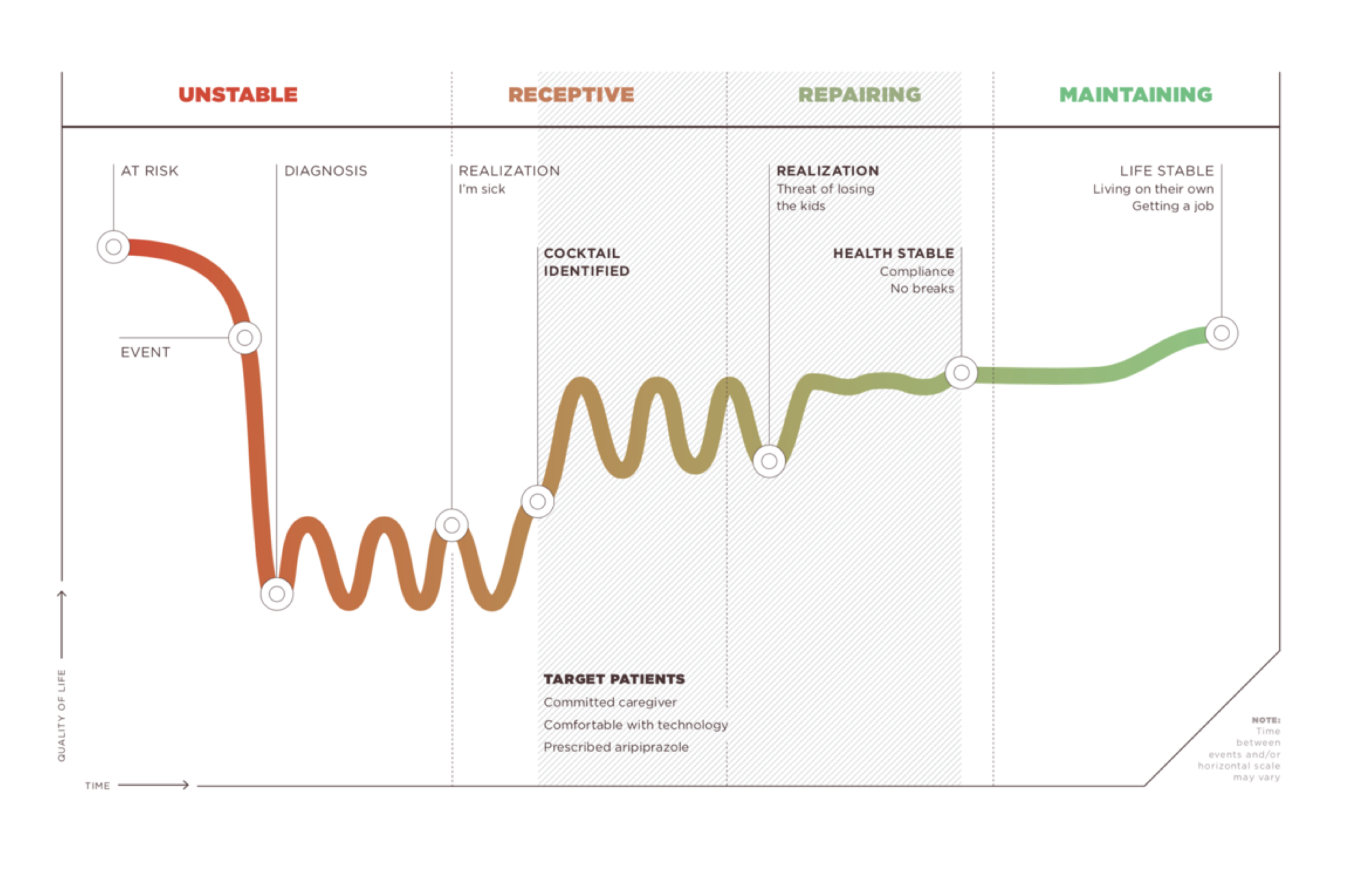
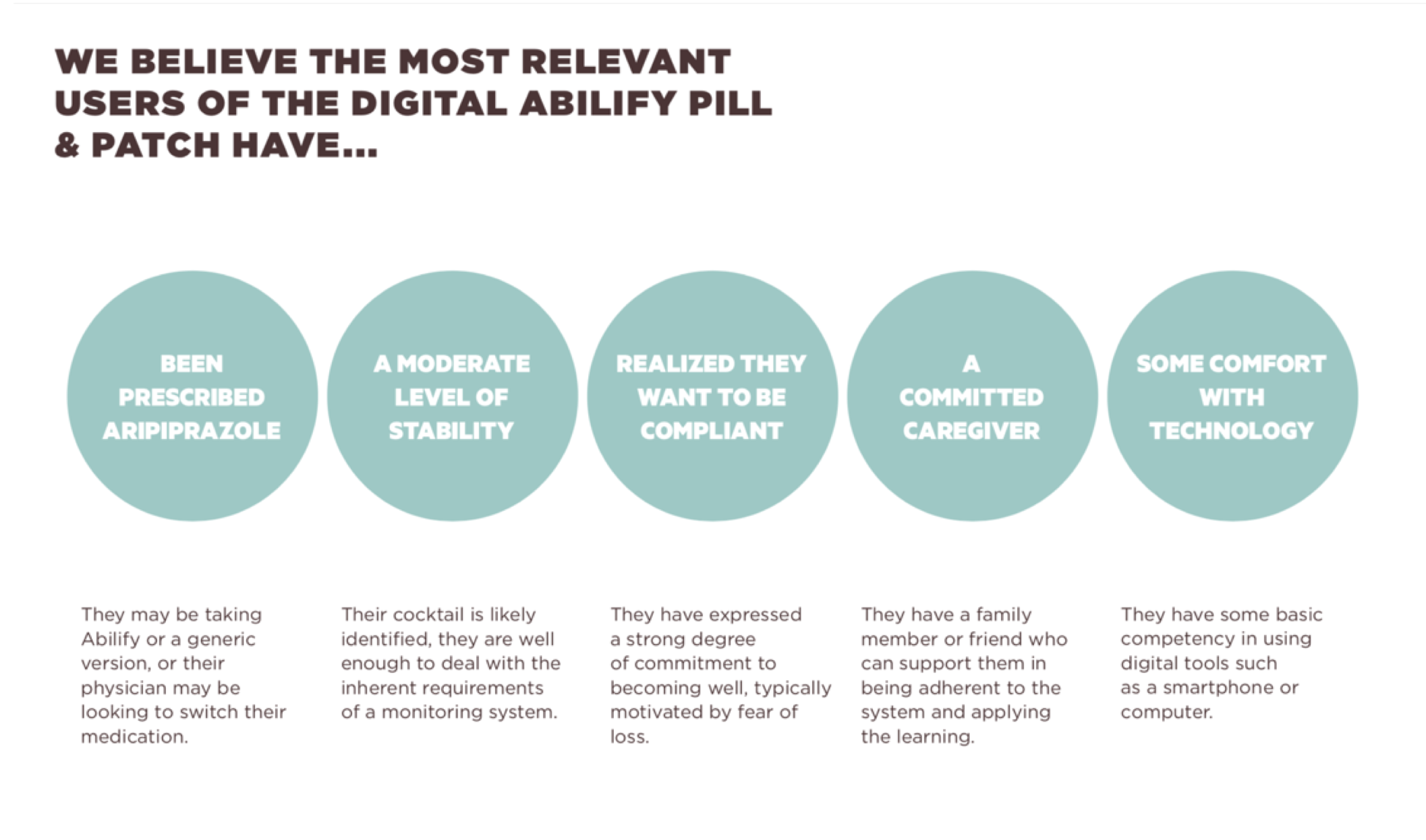
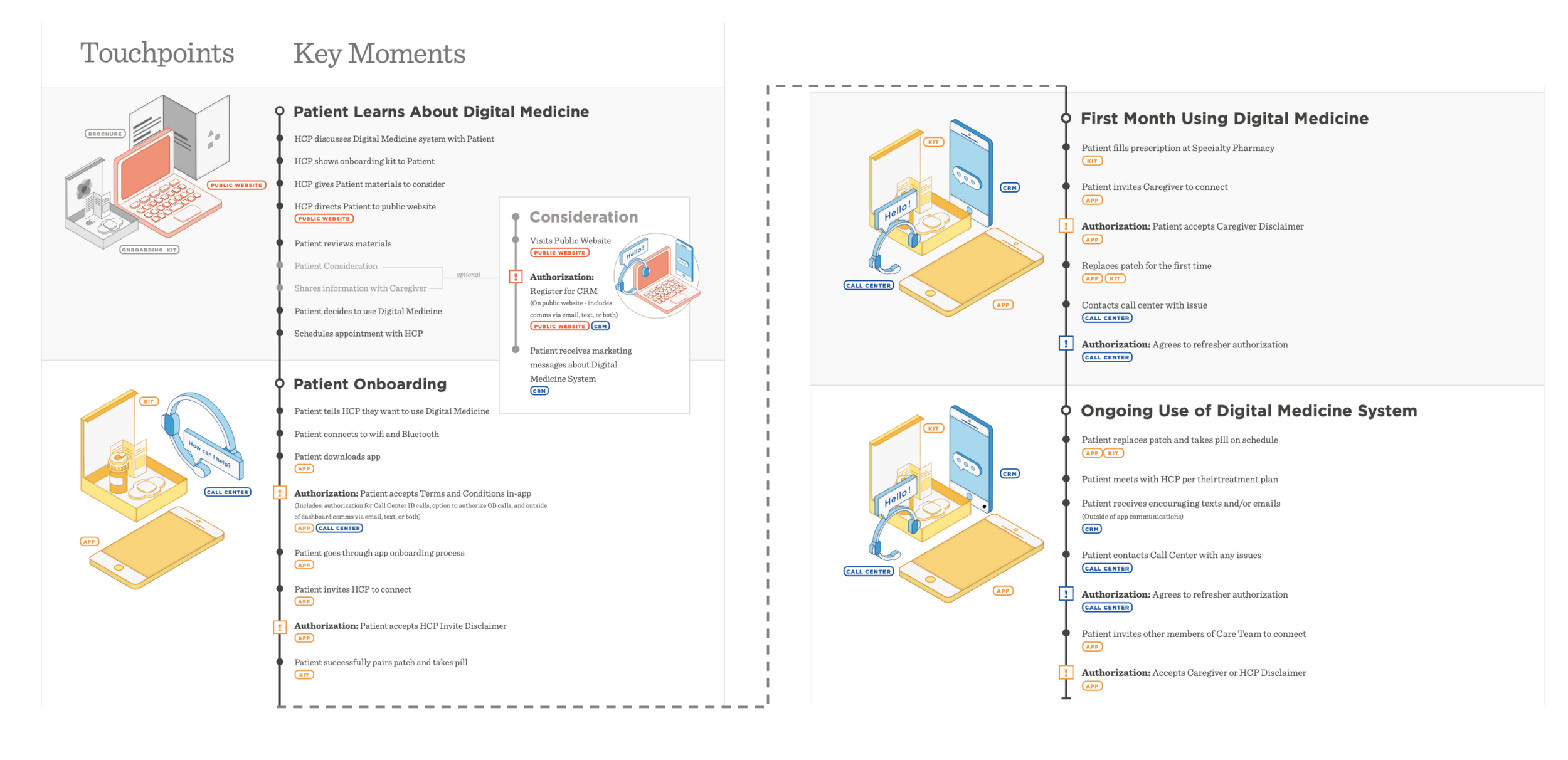


2. Design Review of MyCite App
The Abilify solution for mental health treatment also consisted of MyCite which included a mobile application for patients to track and manage their treatment and a web based application for health care professionals.
When the partnership started MyCite application was already designed and developed. This meant that we also had to understand the application, the design choices and decisions that were made in the creation of the application. Hence the first step was to do a deep dive into the application, review MyCite app, analyze the gap between MyCite and Proteus Discover, to identify opportunities and improvements while working towards a combined Discover-Mental Health app.

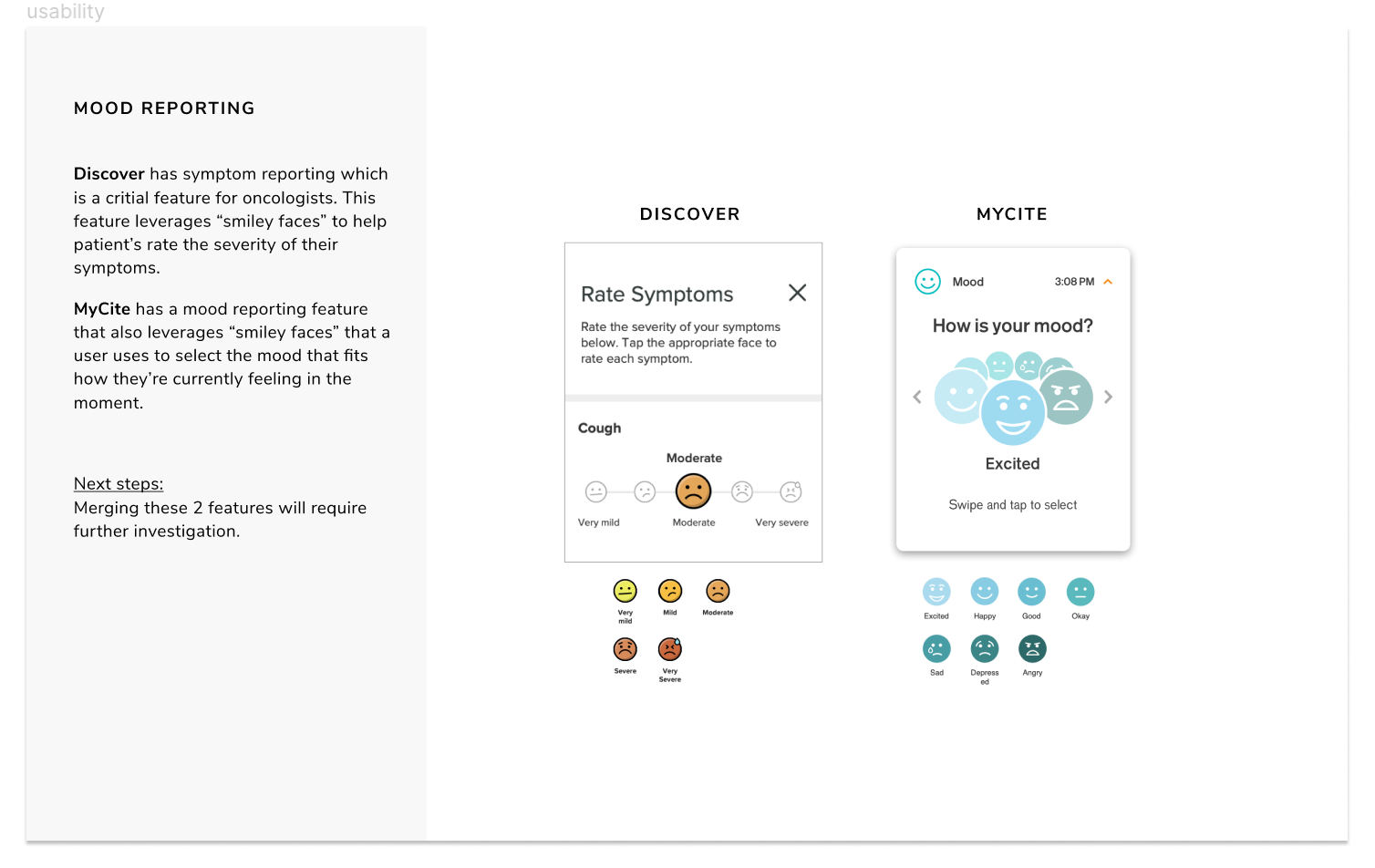

3. Design Roadmap
SO NEXT UP PLANNING..
After a lot of reading and attending workshops, we decided it was now time to plan how the different teams within UX should work together in the space of Mental Health. The UX team at Proteus followed a Triple-track double diamond approach to design. With this agile process in mind, we planned the following months with the following objectives
Short Term goal of shipping MyCite with usability upgrades by early 2020
Long Term goal of combining MyCite with the Proteus app to create Discover Mental Health.
4. Business and Design Goals
The overall business goal with MyCite for both Proteus and Otsuka was to increase the adoption of the app by new users. Each team including Marketing and Sales, Manufacturing and Packaging, Service Delivery etc worked towards the achievement of this goal.
With this overall Business goal, we set our goals for the design team - enhance overall usability of the product by focussing on ease of use, confidence boosting and being trustworthy.
4.Design Prioritization
We are ready to design! But where do we start?
With the goals set, it was time to get into the design specifics. It was time for us to do what we do best, to take up complex problems and shape them into elegant solutions. But where do we start?
So my next task was to
Conduct a UX review on MyCite application.
Identify existing usability issues, UX improvements and feature gaps.
Collaborate with Human Factors, Product Management, User Research and Product Design teams to validate identified issues.
Create a prioritized list of all items, sorted into short term, mid term and long term design problems to solve.
Solve and design solutions for high priority items to facilitate a successful launch of MyCite in early 2020.



MyCite application helps patients to manage their treatment and for Health care Professionals (HCP) to get an overview of the progress with the help of data metrics around medication, rest, mood and activity.
Patients currently connect with each HCP through the HCP’s email. Once the patient sends a request for connection using the email, the HCP accepts the invite and registers into the system through the registration process.
Once the HCP registers into the system, the patient can turn on different data matrices for the HCP to view. Patients can disconnect at any time from the HCP and can reconnect through an email invite process again.
Problem
1. Healthcare providers do not want to share their email.
The current model presented challenges during commercial deployment as some healthcare providers did not want to share their email address with patients. Forcing doctors to share their email was a breach of their privacy.
2.Tedious process for both patients and HCP.
This model was a tedious process both for the patient and HCP. The patient had to send in a connection request and wait for the doctor to accept the connection and register into the system. Sometimes this process took days leaving the patient anxious and waiting. Once HCP accepts the connection, the patient had to individually turn on each data metrics(Mood, Activity, Rest etc) they wished to share. Patients often forget this step or would only share partial data with the doctor. This meant that the HCP did not have a holistic view of the patient’s treatment progress and had to do follow up calls requesting data.
3.Inefficient and Non-scalable.
The 1-to-1 connection model only allows a single provider to be granted access as opposed to an entire care team that manages a patient. This requires each member of the care team to be connected individually by the patient. This method was not scalable.
WHAT IS A BIGGER CHALLENGE THAN DESIGNING FOR A NEW SPACE?
A FDA regulated product for a new space! Both Proteus Discover and Otsuka MyCite applications are FDA approved and regulated. This means that there are lot of restrictions while designing the app and a lot of review and approval process to be done through the FDA before the app can be submitted to the app store or launched.
When we started working on MyCite, Otsuka had already completed the FDA approval process for the 2020 release of MyCite App. This meant that the changes we could now do to the app should be under a CBE-30 supplement (absolute minimal UI change with no user flow modification) in order to prevent a resubmission, which would take months to prepare and to be approved.
So for Connection Model, we opted for a CBE-30 and hence any solution we find should not trigger a FDA resubmission and must have an absolute minimum UI change from the current app.
The team worked to understand the patient and HCP journey during the connection process to come up with an efficient and scalable solution. The solution that was decided on included a more structured approach of creating an organization for a facility and connecting patients to their care team using a unique code.
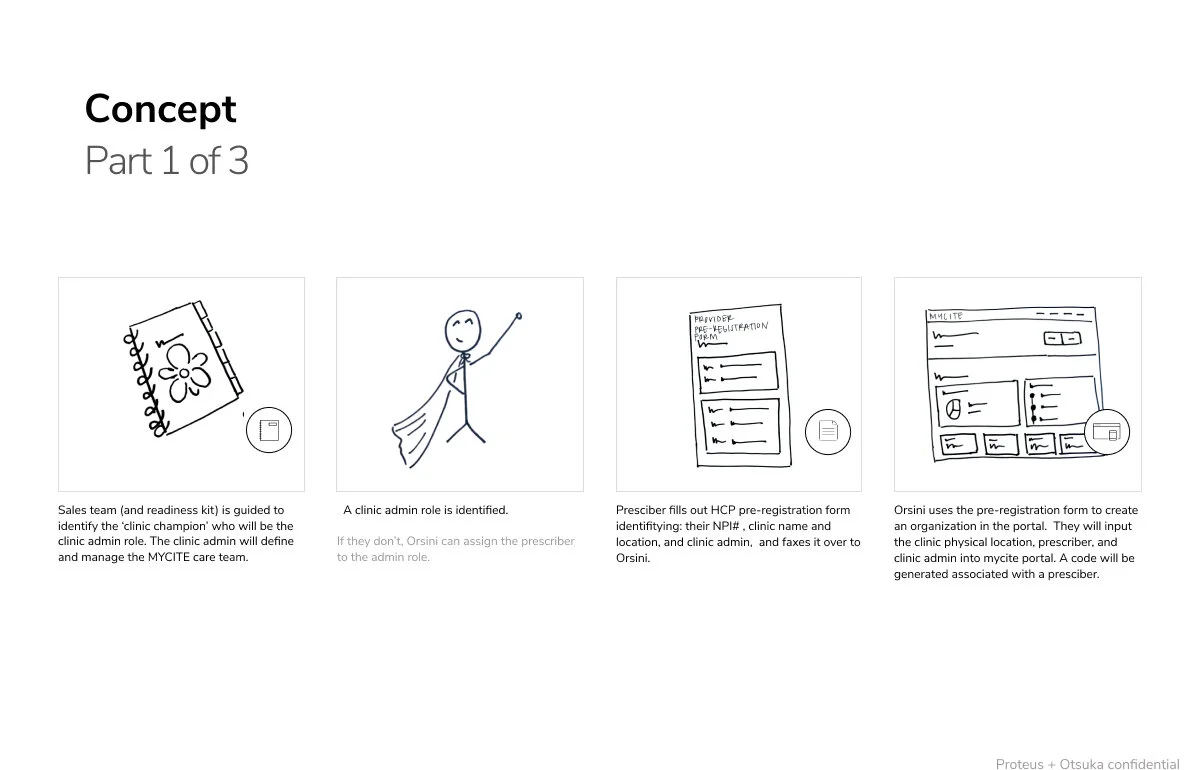



1. A STRUCTURED ORGANIZATION
An organization is created for each type of facility ranging from a single practitioner facility to a large care facility. Each organization would had an administrator attached to it who takes care of the administrational tasks related to maintaining the organization and in registering doctors, prescribers and care team to an organization.
2. UNIQUE CODE BASED CONNECTION
As opposed to an email, a unique code would be used to connect a patient to the care team. A code is attached to a prescribing physician and is generated when a physician is registered in the organization.
3. INSTANT CONNECTION
The code based connection is instant. This means that once the patient enters the connection code and initiates the connection, the connection is established instantly thus eliminating the wait time that was presented earlier when a physician had to accept the invite and register into the system.
4. One to Many Connection
With the unique code, the patient is now connected to their entire care team instantly. Thus a patient need not send and manage individual requests to each member of the care team
5. ALL IN OR NOTHING DATA SHARING
A controversial decision, but highly valuable and impactful, was the decision to have an All-In or Nothing data model, where once the patient connects to a care team they automatically share their tablet, mood, rest and activity data with the care team. This helps to create a holistic view of the patients treatment progress.
Tasks and Scenarios
Its time we split up…
Once we reached on a model that worked the best, it was time to dive down into the design details and it was time to split the HCP experience from the Patient experience.
Together but separately we designed the provider side (web application) and the patient side(mobile application). We created a detailed set of tasks for each of the user persona including
Patient
Physician
Prescriber
Org Admin
Pharmacy Admin
Once the tasks were finalized, we jotted down possible scenarios and how one set of users would interact with the other.

Patient Experience : User Flow
For the patient experience , on the mobile device, an end to end flow for the connection model was created. This helped us to get a close up view of the step by step process through which a connection is established and maintained.
Even though the user flow is very helpful to designers, I have often found it to be more useful for Product Management and Software Engineering to get a clear idea on the process. Discussing the flow with the PMs, Cloud Engineers, Software developers and QA Engineers helped us to catch any scenarios or use cases we missed, to understand the technical constraints better and to align with the product management and business needs.
Wireframes and Iterations
TWEAKING THE EXISTING DESIGNS WITHOUT RAISING ALARMS…
The next few weeks was challenging. At this stage, we would have been comfortable if we could start from scratch and build the system specifically for the current model. But with CBE-30 in picture, this was impossible.
We had to take each of the existing screen and work on it a bit at a time to see what can be moved around to establish the new connection model.
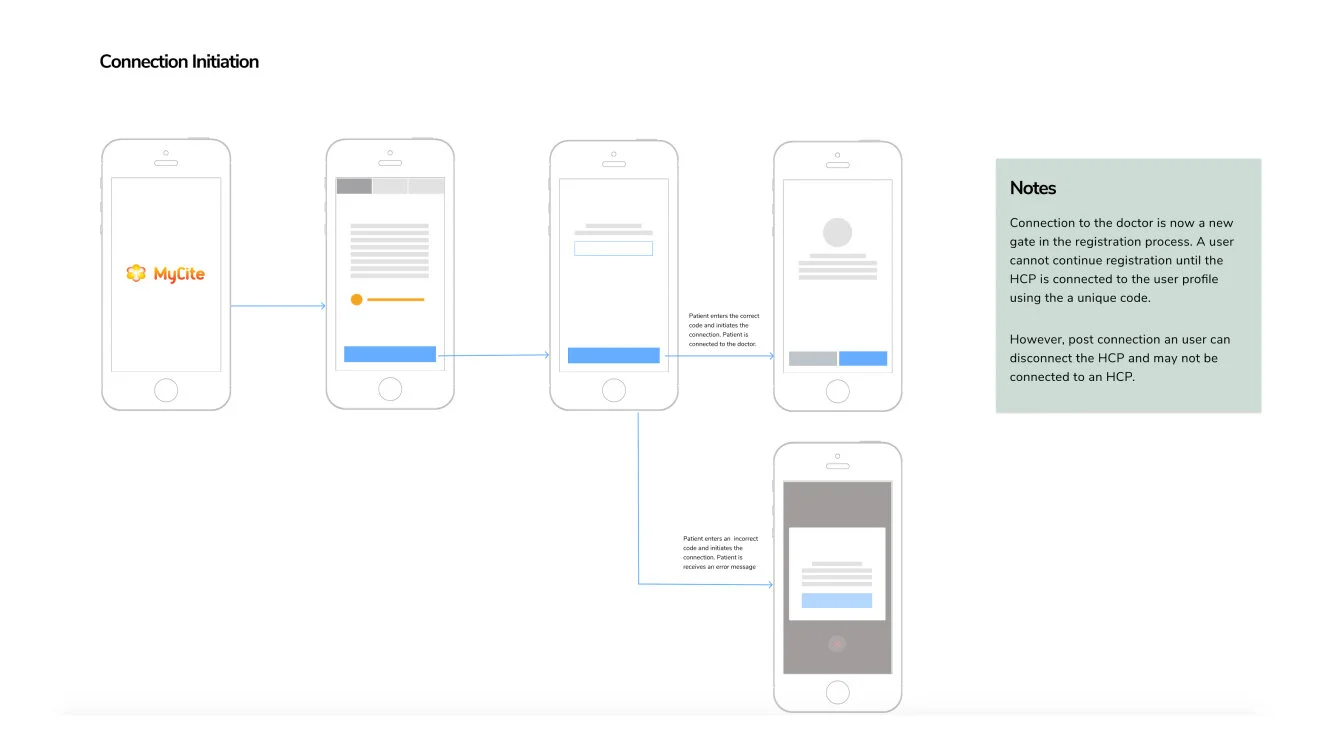

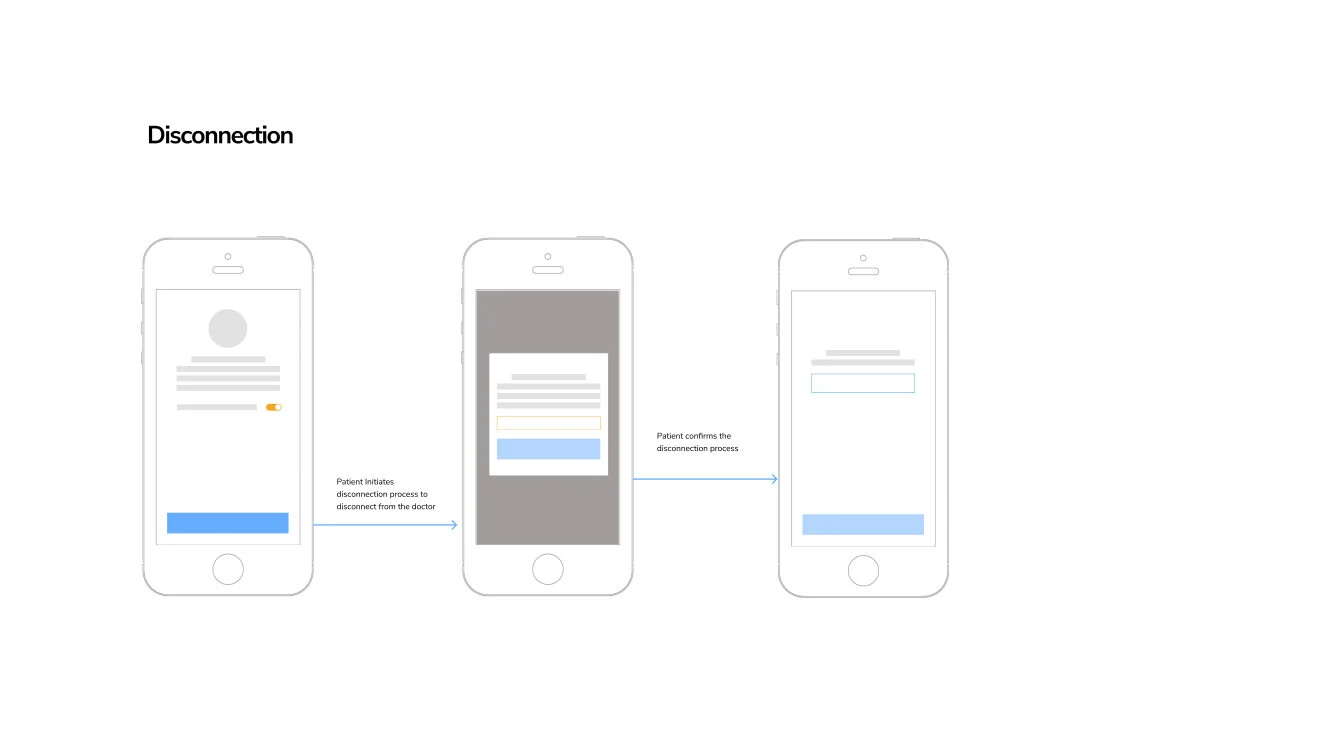

The process included many back and froth with the Human Factors to ensure that the design alterations were not a violation to CBE-30. Given below is one such iteration of design tweaking. Additions, deletions and minimal copy changes were done to each screen.
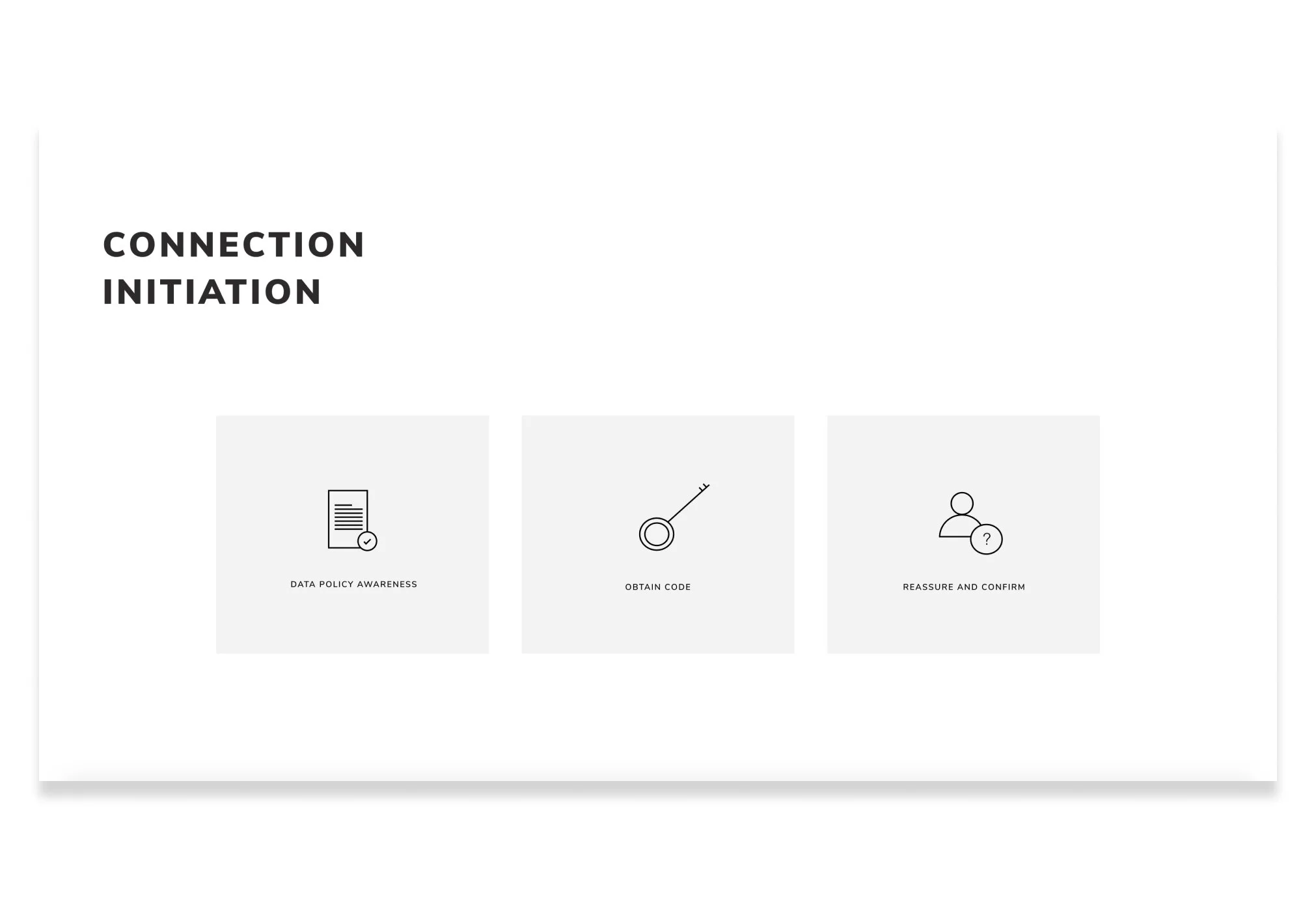
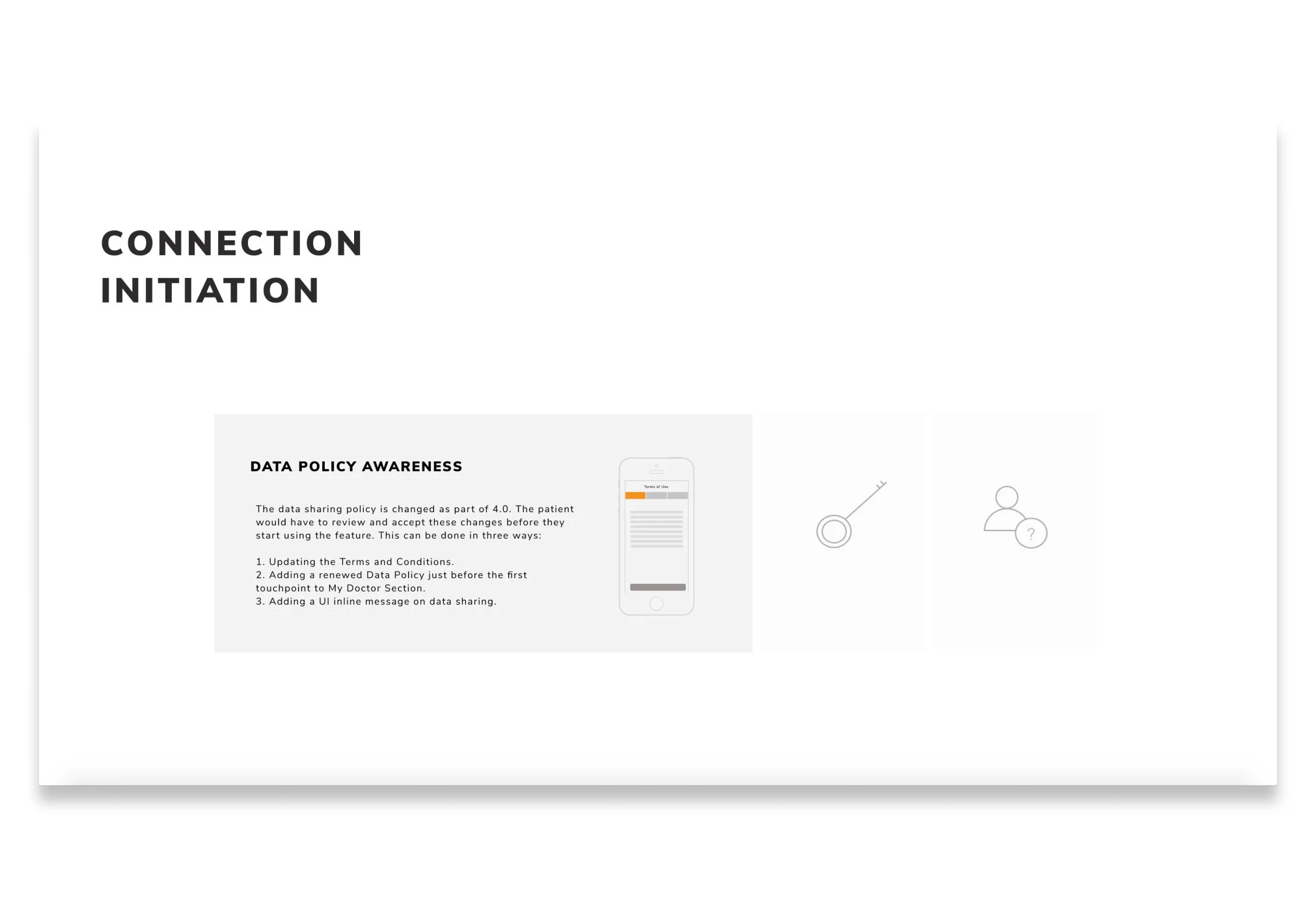

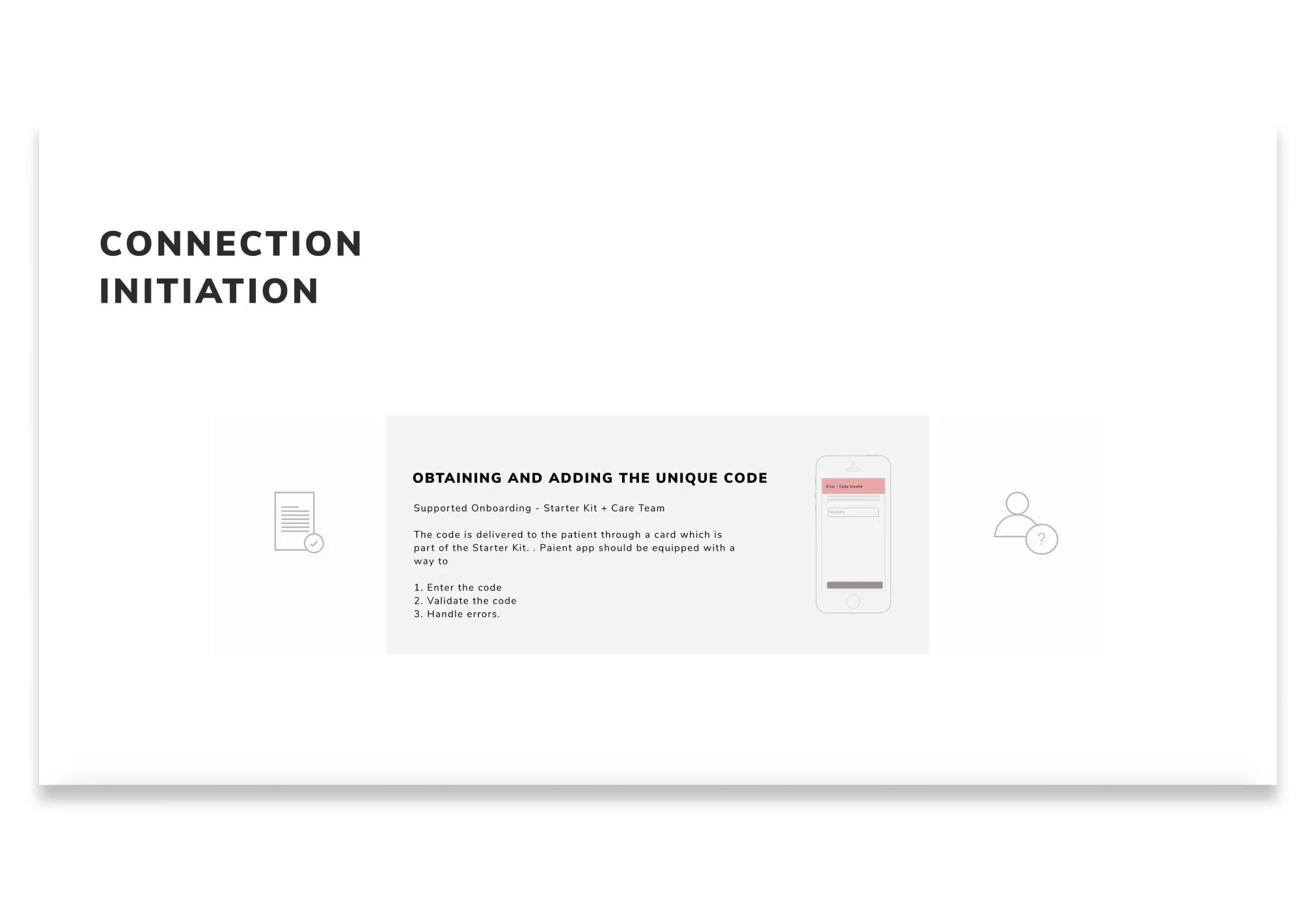

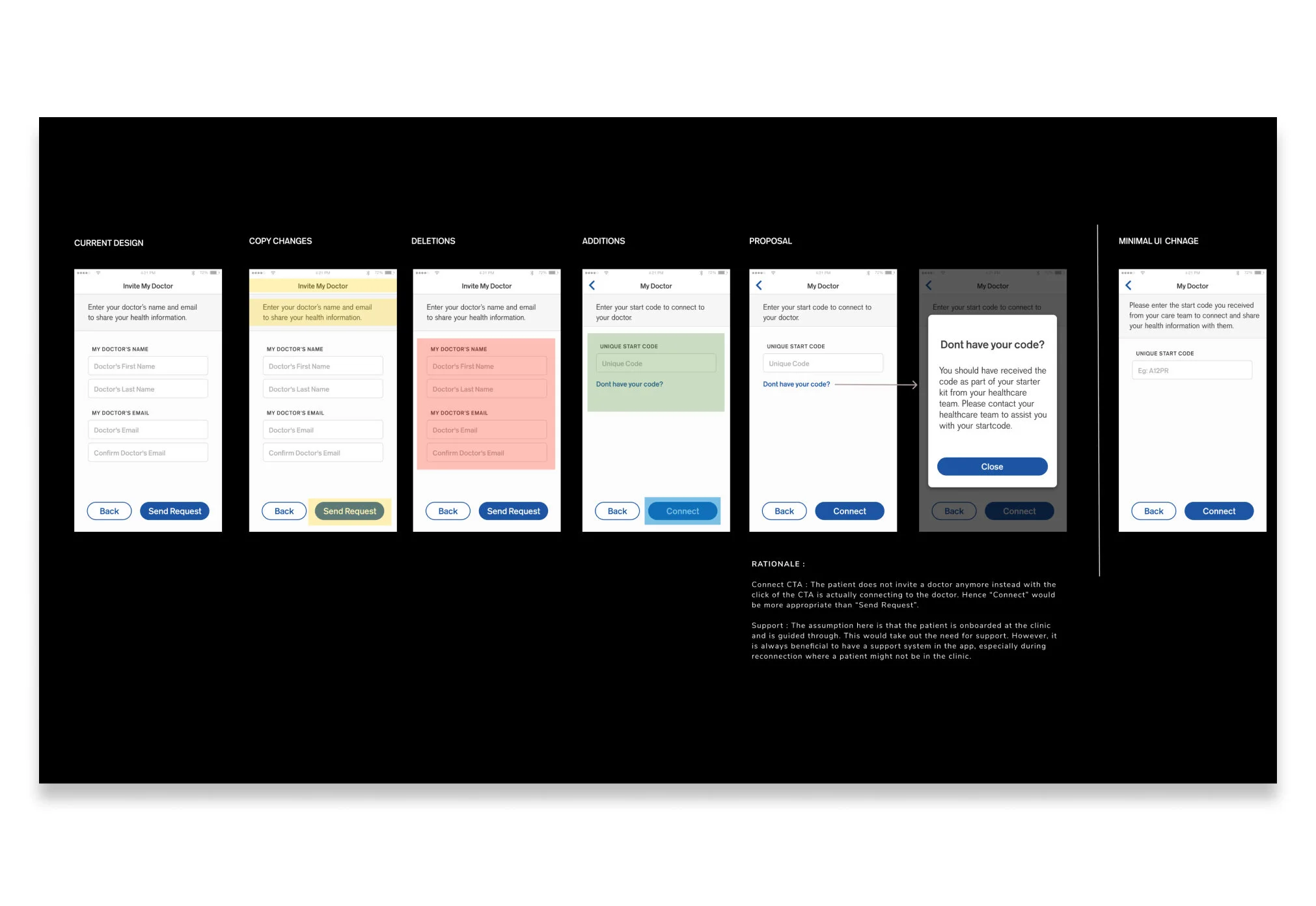
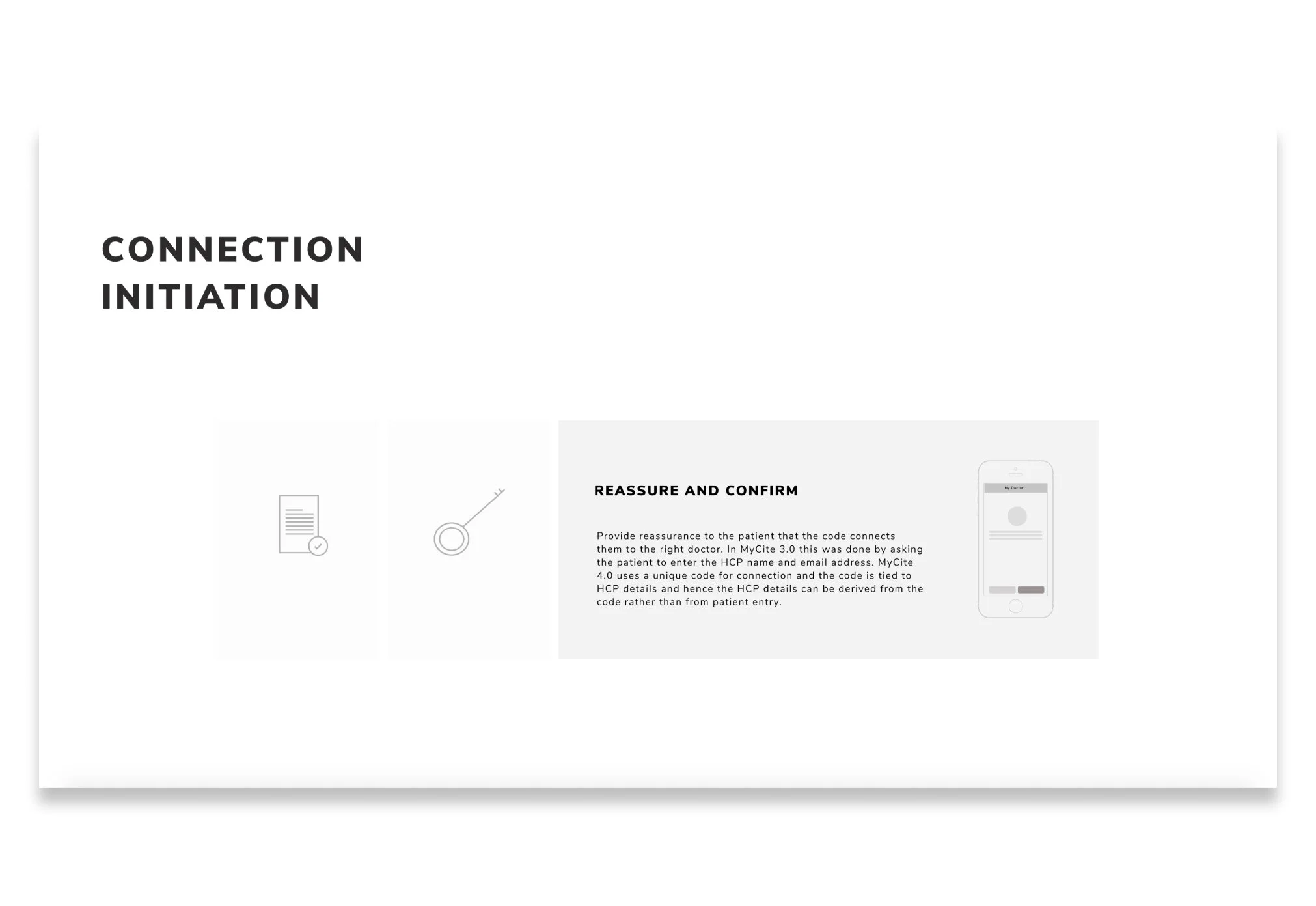


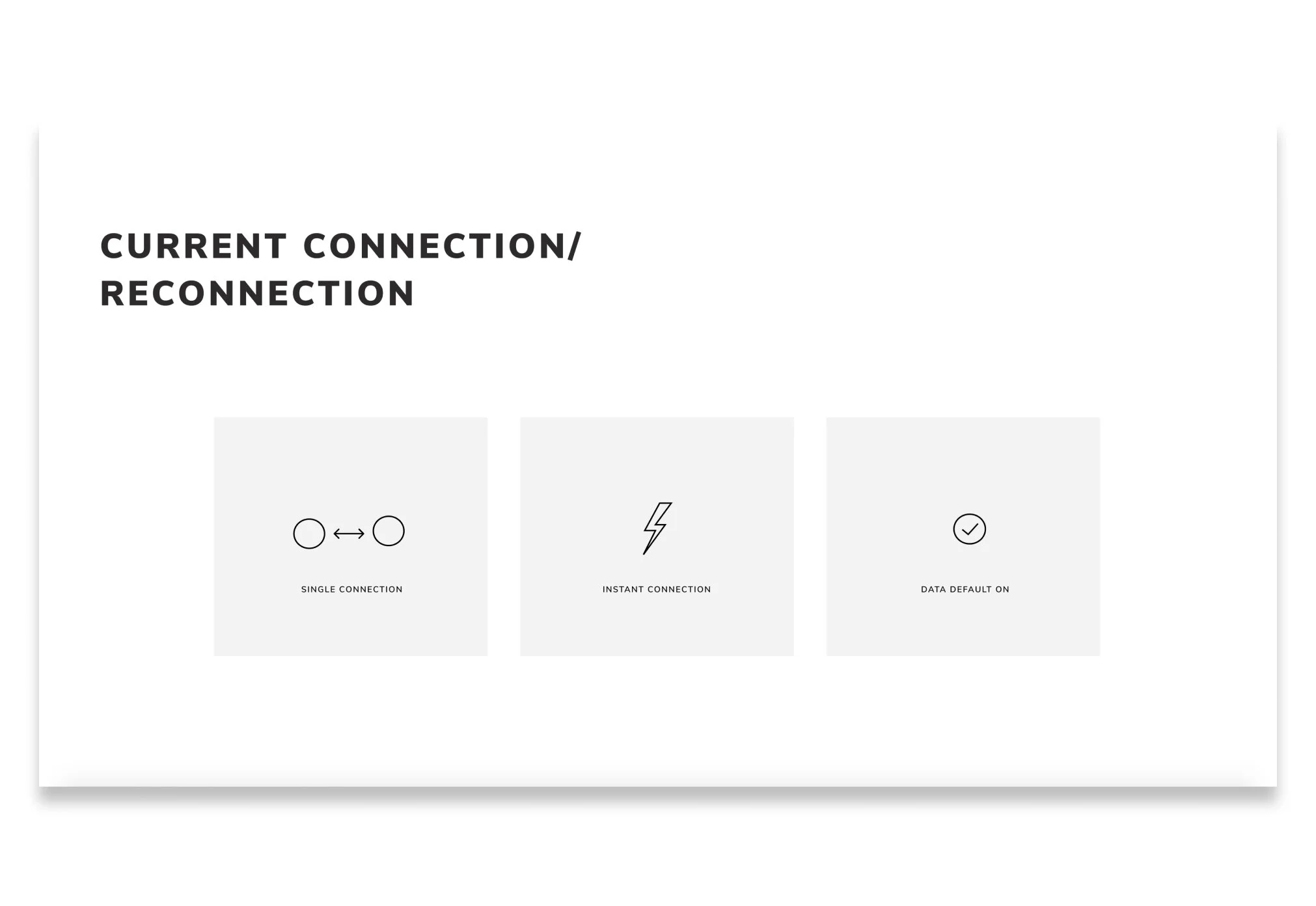
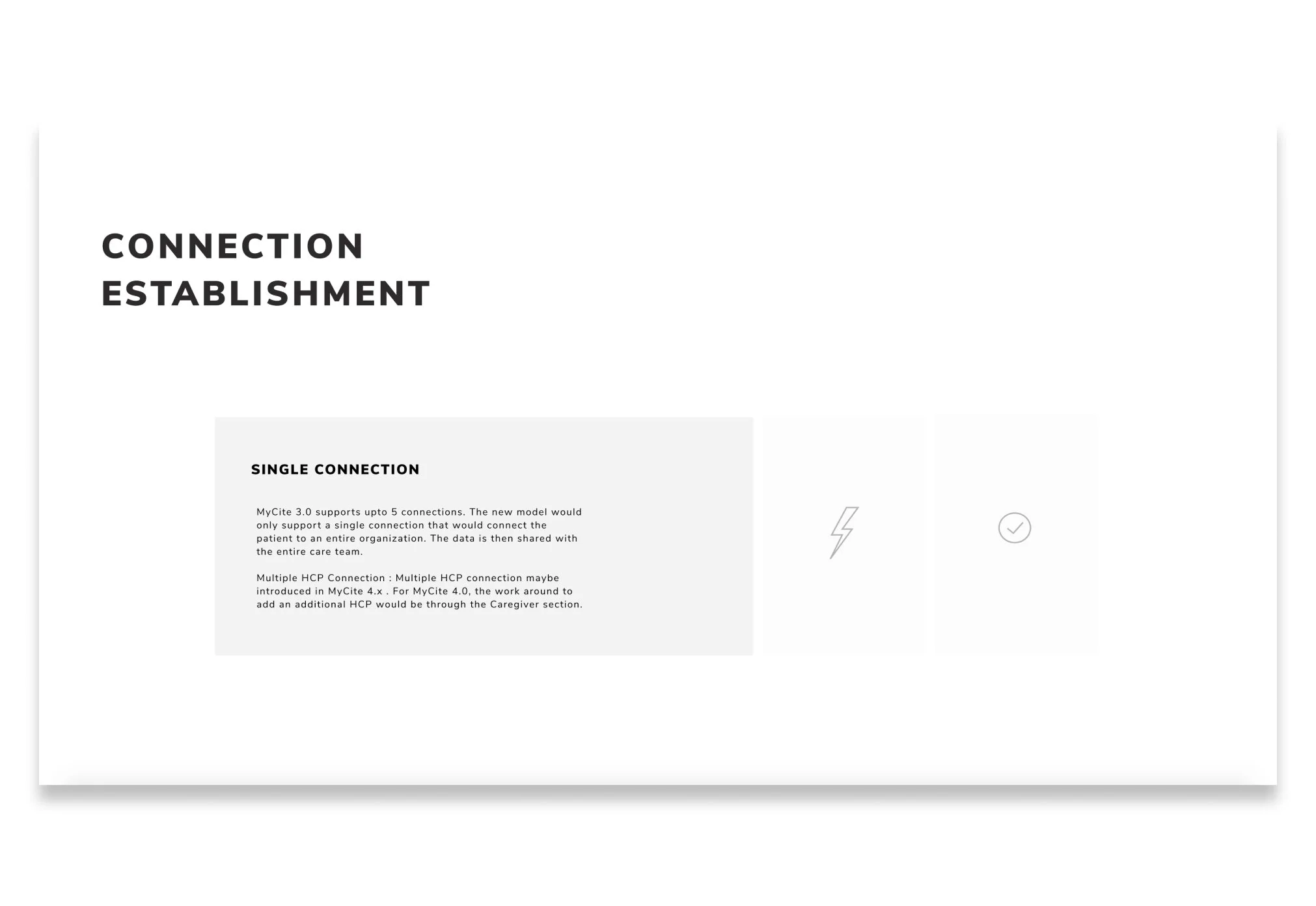


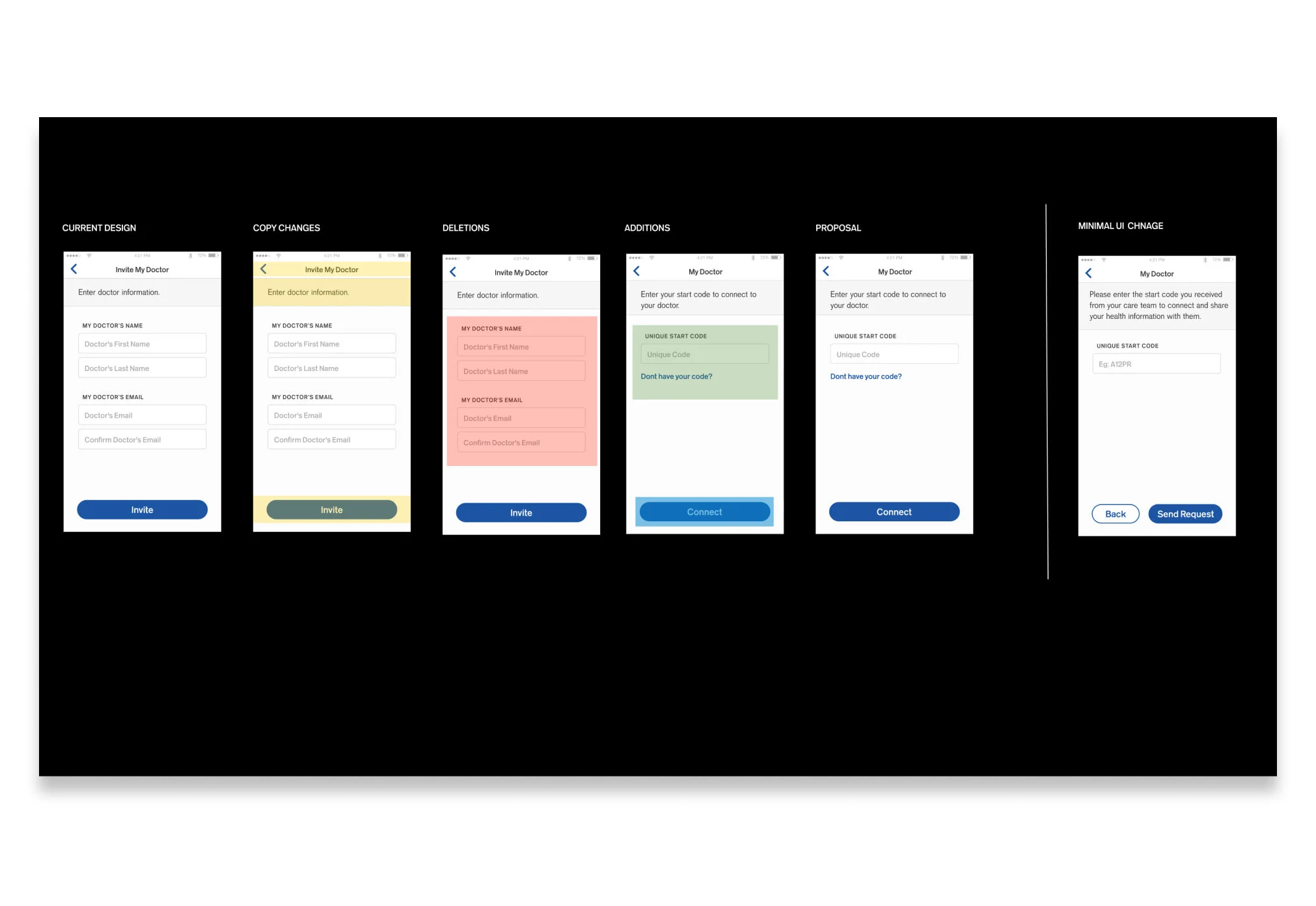
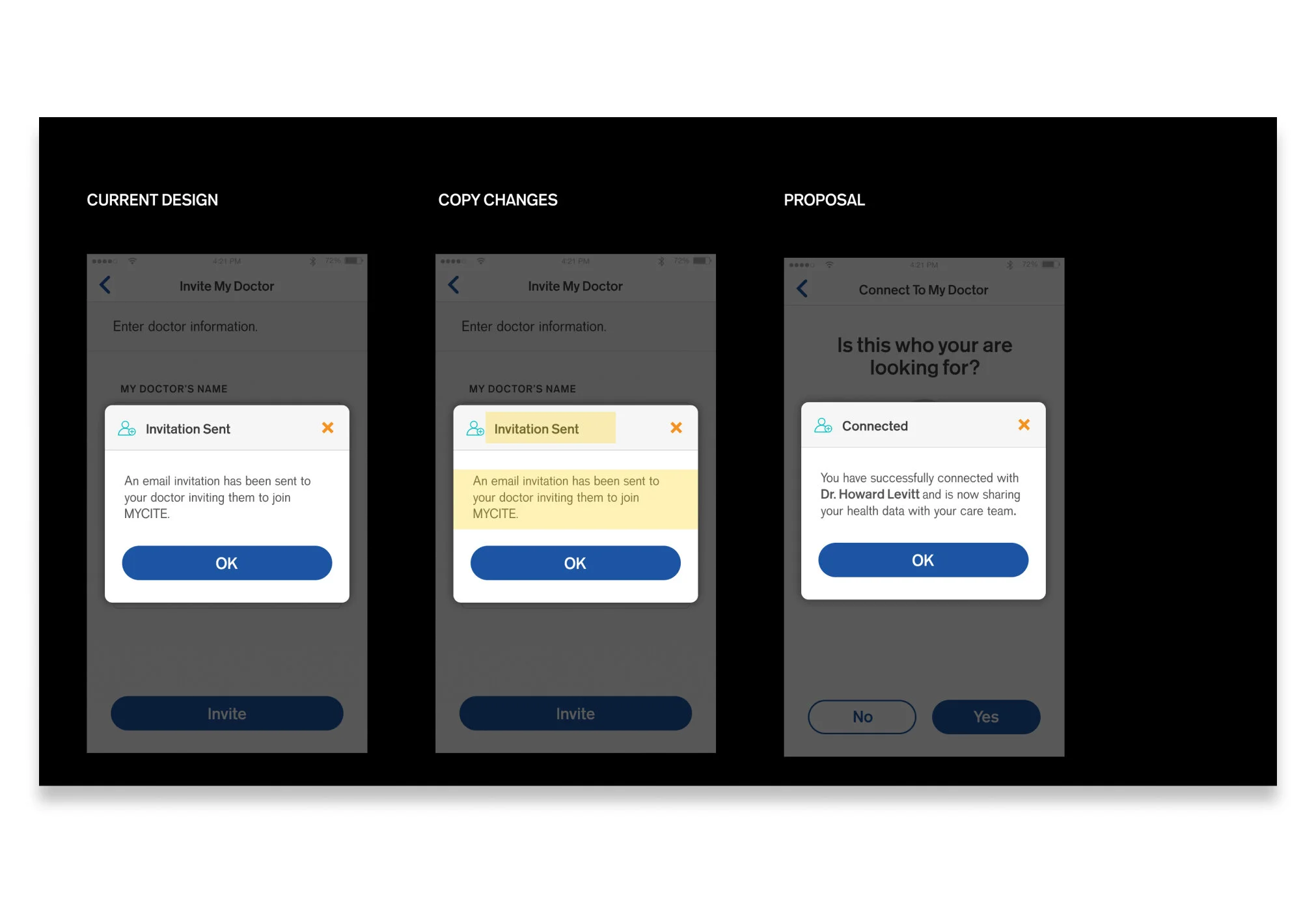

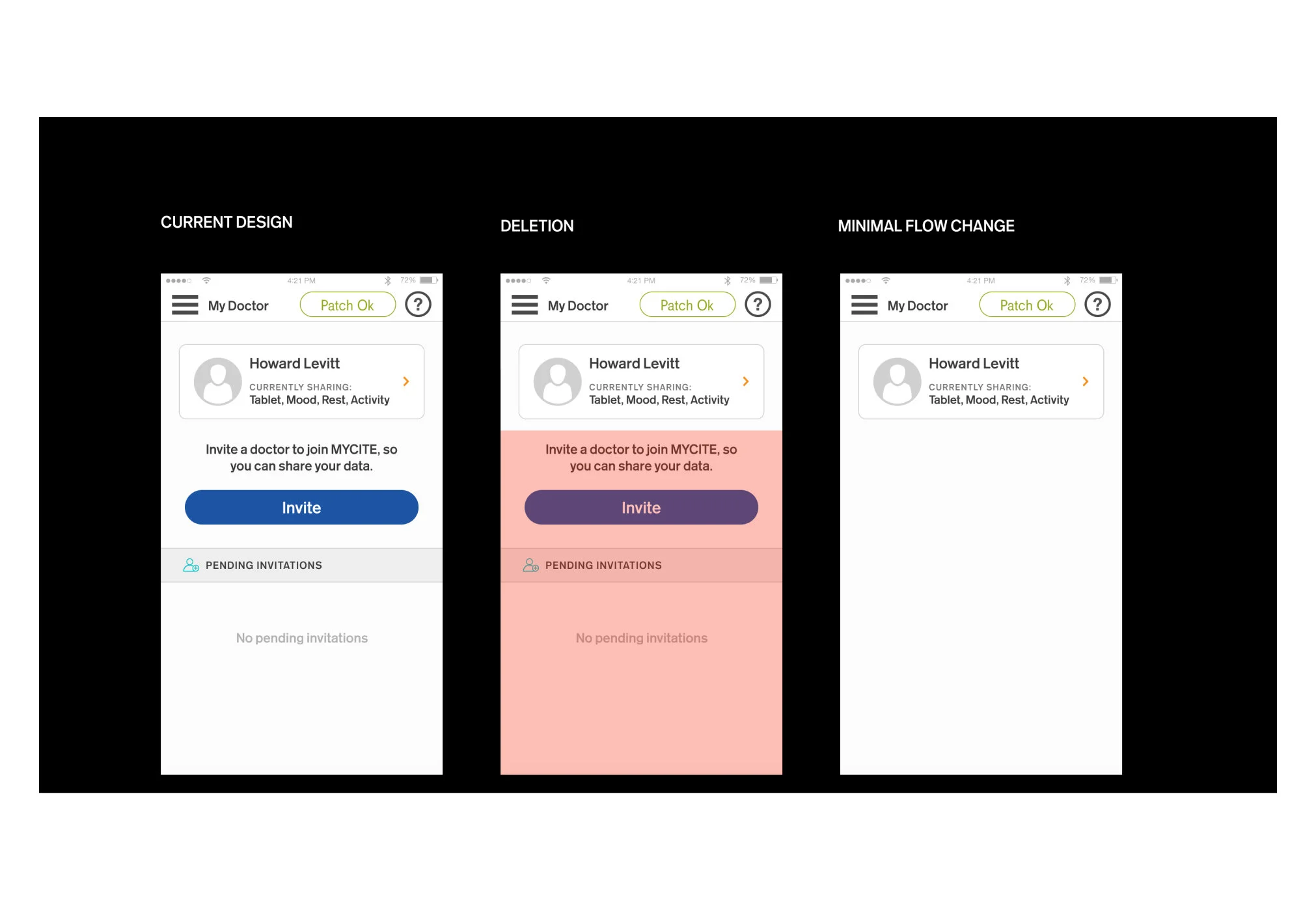

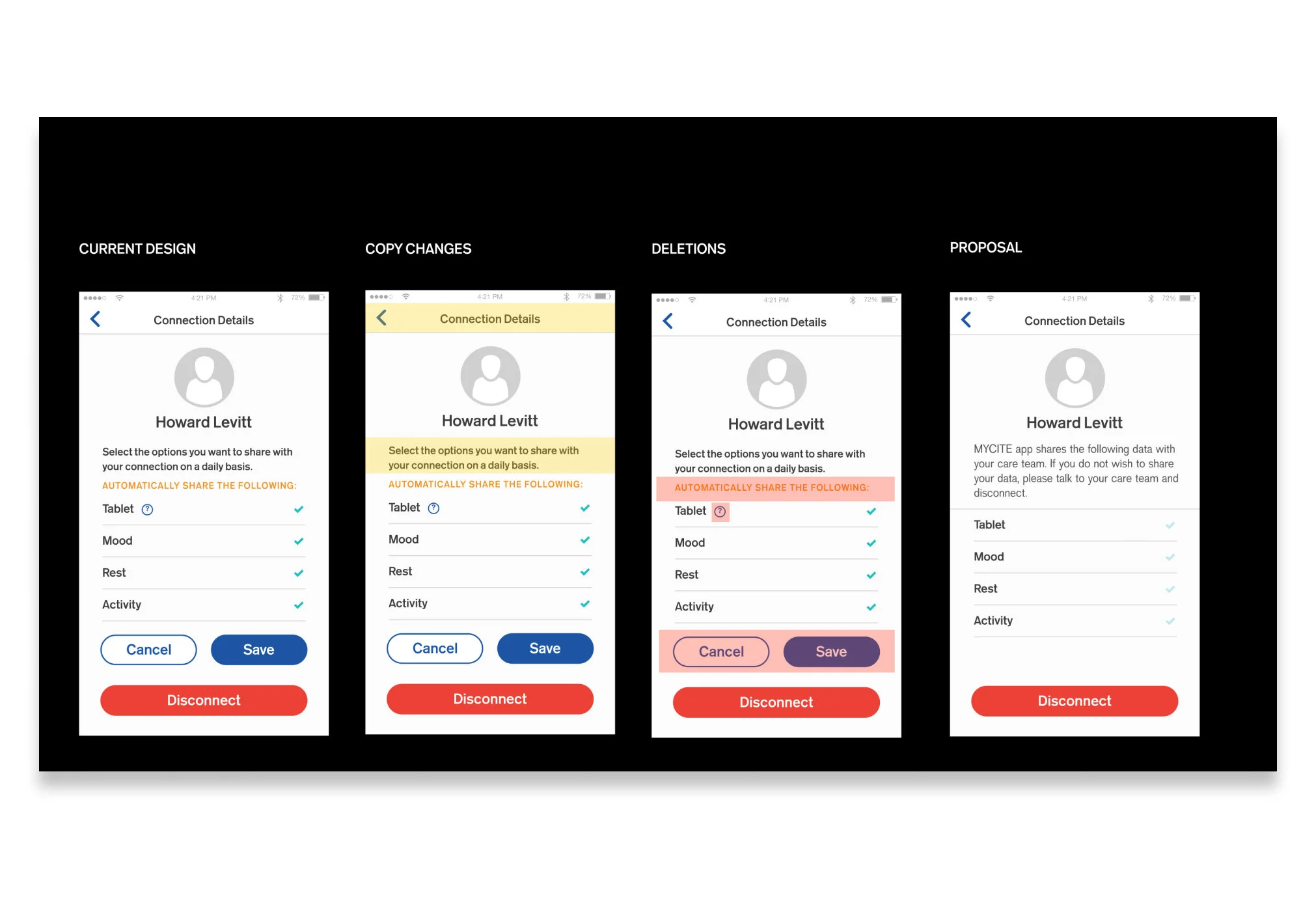
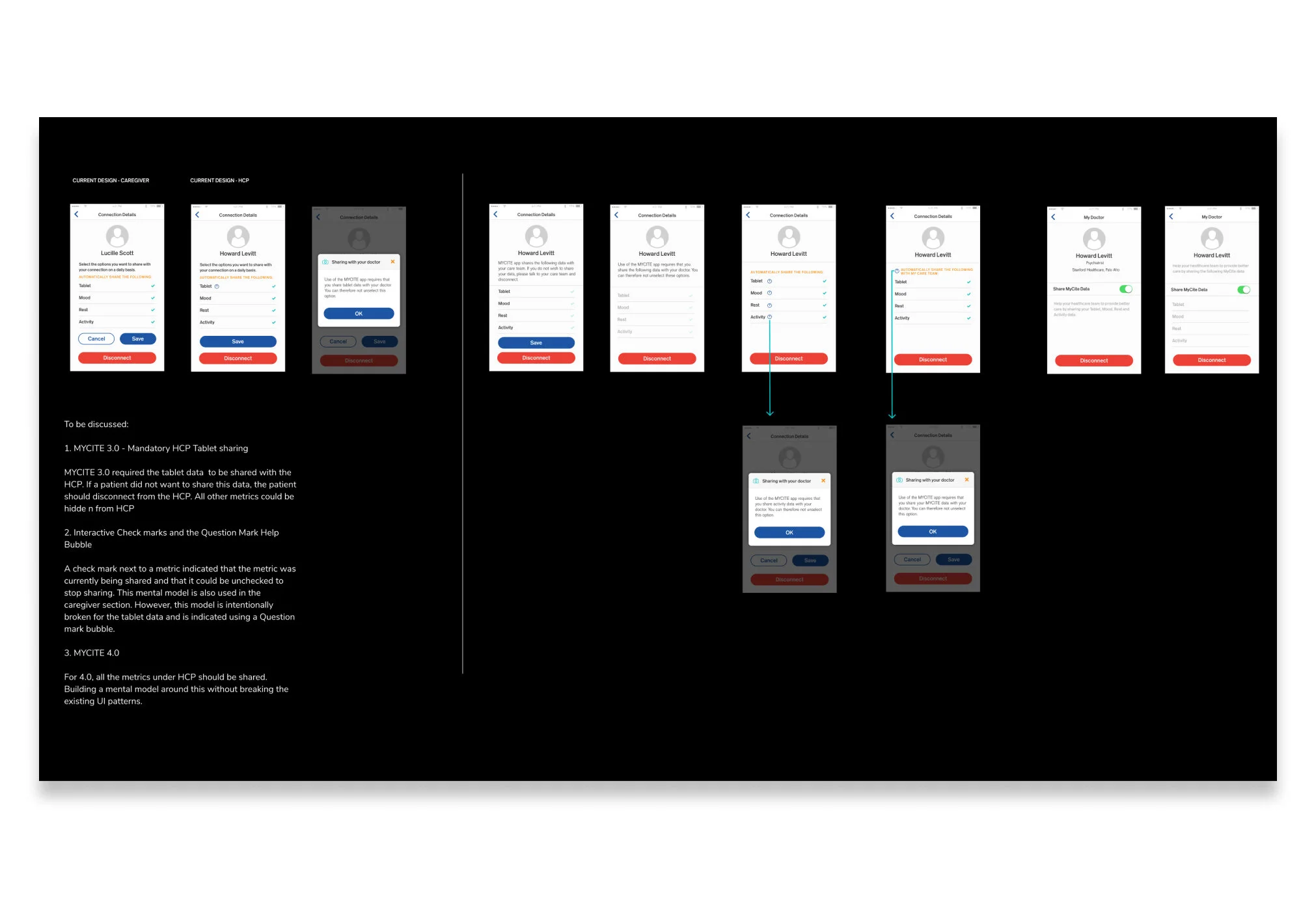
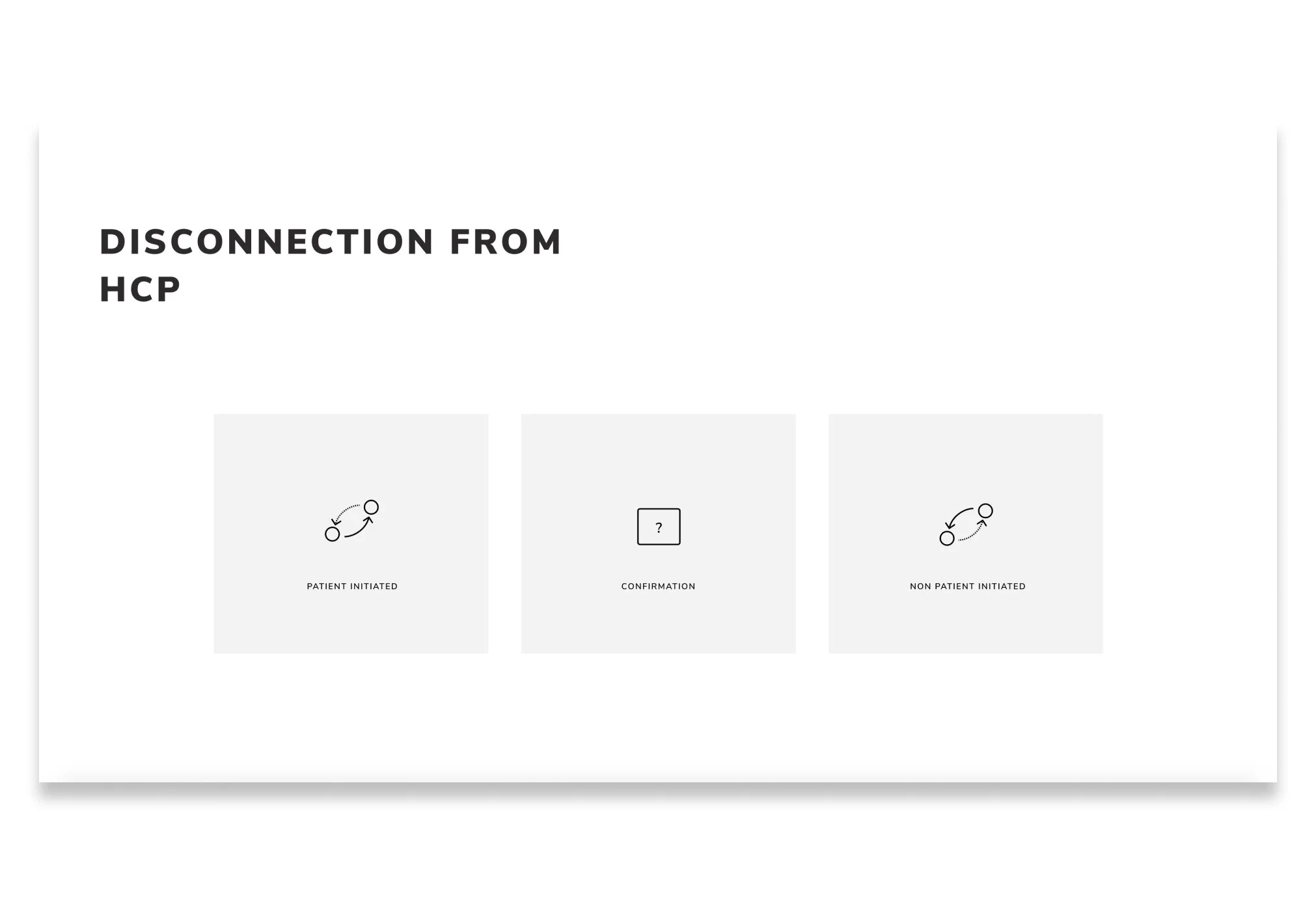




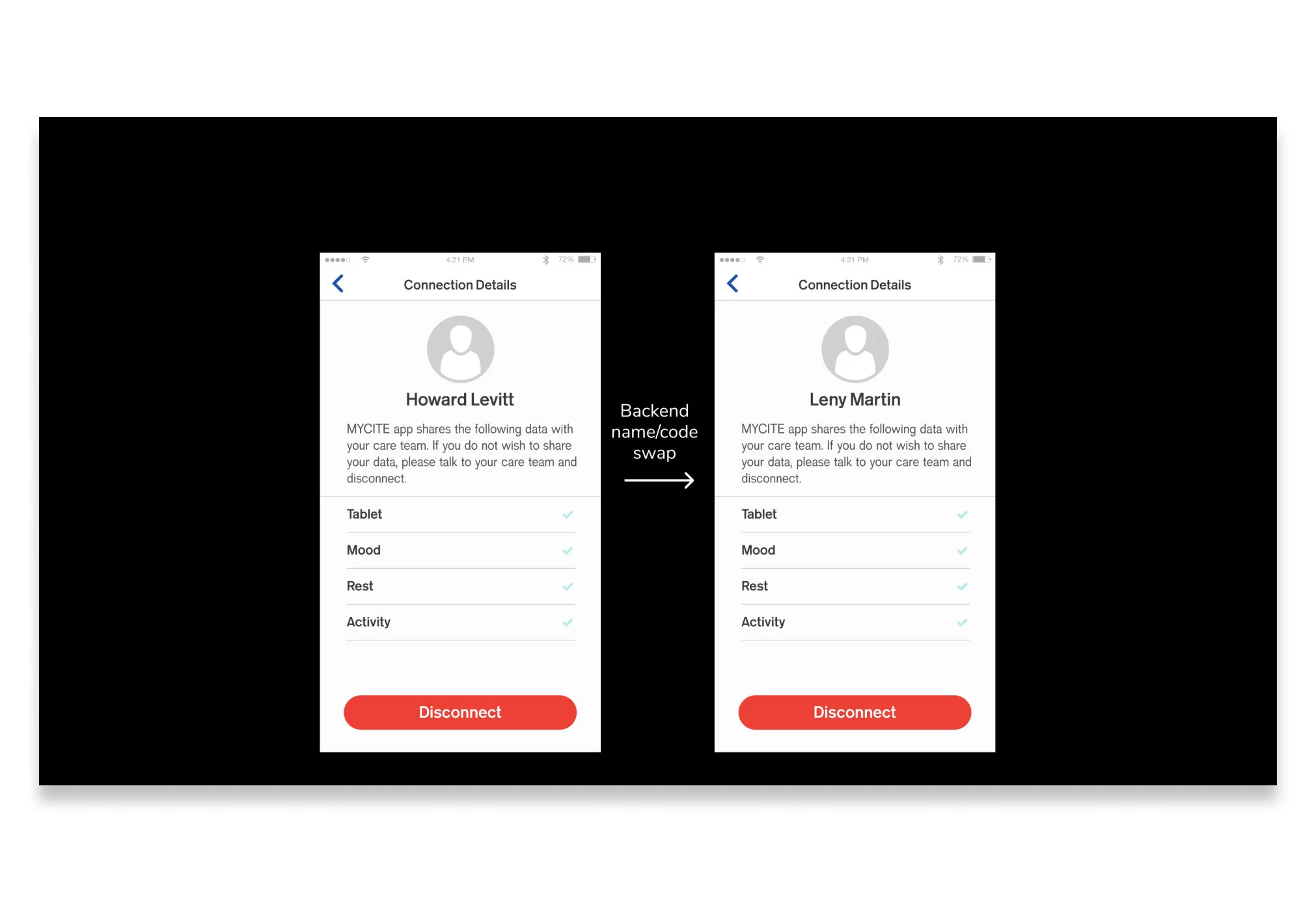
By changing the MyCite connection model from requiring a patient to input their prescriber’s email to a unique code, prescriber pre-enrollments & patient registrations process became more smooth. Prescribers felt more confident and secure in signing up for MyCite.
By shifting the MyCite set up burden away from the HCP to a 3rd party (Orsini), portal completed registrations (acquisition) will increase, because HCPs will have a lower barrier to entry.
By changing the MyCite connection model from requiring a patient to connect to each member of their care-team individually to connecting to their entire team by entering a code, the time a patient spends in onboarding will decrease, and patients will have a lower barrier to connection.
By changing the data sharing model to an All-In model, HCP’s would have a better understanding of the patient’s progress and can improve patient care and tailor the treatment properly.




















